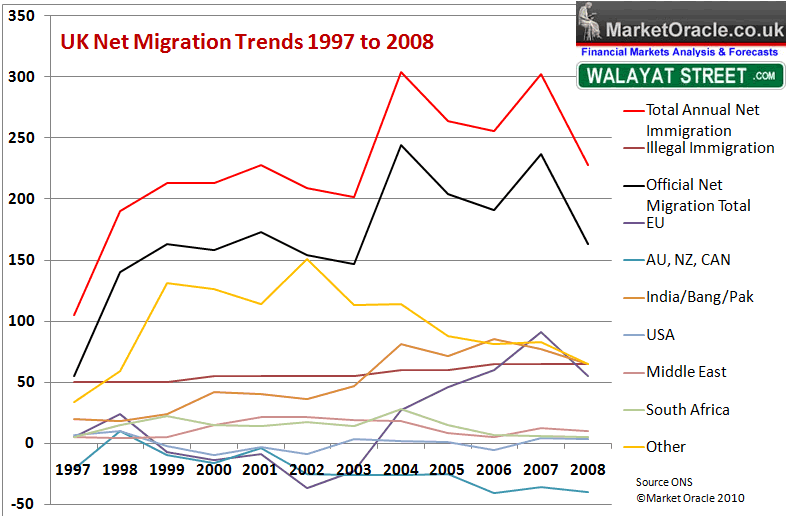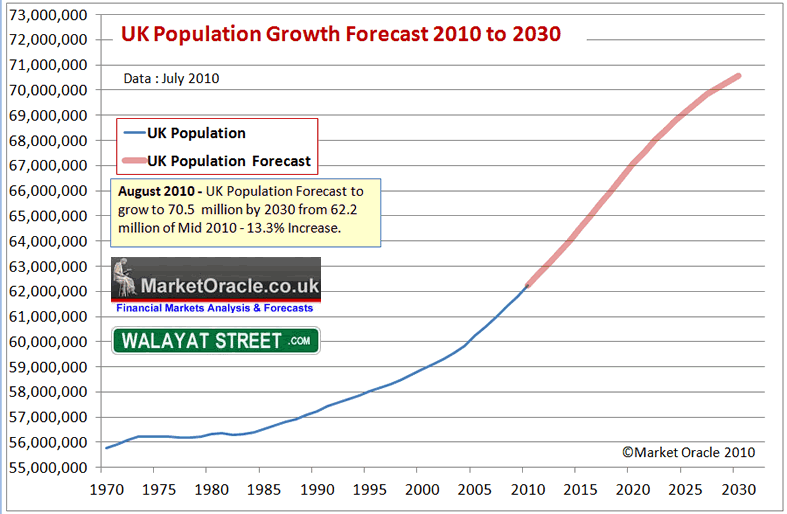Results 1 to 1 of 1
Thread Information
Users Browsing this Thread
There are currently 1 users browsing this thread. (0 members and 1 guests)
-
08-09-2010, 05:49 PM #1Senior Member


- Join Date
- May 2007
- Location
- South West Florida (Behind friendly lines but still in Occupied Territory)
- Posts
- 117,696
UK Population Growth, Immigration Trend Forecast 2010- 2030
UK Population Growth and Immigration Trend Forecast 2010 to 2030
Economics / Demographics
Aug 02, 2010 - 12:27 AM
By: Nadeem_Walayat
Whilst Britain is rarely if ever at the top of the various quality of life statistics such as economic growth, average earnings, disposable incomes, living space, healthcare services, pensions, personal freedoms and education. However when taken as a whole package, Britain remains one of the worlds most civilised countries that acts as a beacon that continues to attract peoples form all over the developing and developed world, which continues to push the UK population ever higher despite many Western European countries experiencing population stagnation or even falling populations such as Germany, where in fact 1/3rd of the annual rise in Europe's population as a whole takes place in Britain.

The above immigration data illustrates that the UK experiences average net immigration of 225k per year with most immigrants from the Indian Sub continent, Eastern Europe, South Africa, Middle East and in more recent years China. Against which significant net emigration occurs to Australia, New Zealand and Canada. However official data excludes illegal immigration that averages at an estimated rate of between 20-40,000 per year thus putting added upward pressure on population growth.
Once the net birth rate of 200k at 0.33% of the population is factored into the equation, the UK population is currently increasing at an average rate of approx 425,000 per year, which targets a rise to at least 66 million from the current 62.2 million within the next 10 years. The anticipated minimum increase of 4.25 million in 10 years is equivalent to 8 large cities that are frankly not going to be built.
The existing immigration trends from immigration from Eastern Europe are likely to be supplemented further over the next 10 years as the exploding middle and upper middle classes of countries such as China, India and Brazil that number in the hundreds of millions, will use their new found wealth in significant numbers to seek to relocate to more civilised countries such as Britain, United States, Australia and Canada, though the obvious difference between the four being that Britain does not have the wide open spaces of the alternative destinations therefore even a relatively small influx from the hundreds of millions of rich migrants will significantly impact on forecast trend expectations for an increase of 4.25 million.
Further upward immigration pressure is expected to result as a consequence of the increase in the trend for illegal immigration, and refugee and asylum seekers from war torn areas of the world from a pool of some 50 million refugees. However against this the next 10 years could see over a 100 million climate change refugees from predominantly poor developing nations as a consequence of drought, famine, rising sea levels and floods that could increase the annual intake into the UK anywhere by between 40,000 and 100,000 per year, though more likely to start to materialise later in the decade.
New Government Immigration Controls
The coalition government is following along a similar path as the last Labour government by talking tough on immigration controls but likely not to deliver anything significant. The government is constrained on what it can actually do to limit immigration as it cannot affect immigration from within Europe, refugee and asylum seekers, illegal immigration many of whom are over staying students (300k student visas per year) or the bulk of wealth based migration that takes place annually. Therefore the government is focusing on capping skilled workers work permits to 24,000 a year down from approx 50,000 (plus dependants) which has resulted in much outrage from big business. At the end of the day all of the governments measures once implemented are not going to effect net immigration by more than about 10% and probably less considering the resulting increase in illegal immigration, thereby little net impact on expected immigration trend expectations.
UK Population Growth Forecast Conclusion
The assumptions being factored into the UK population growth forecast are for a natural UK population growth rate of births exceeding deaths of 0.33% per year (current 200k), coupled with net average current immigration trend of 240k per year, supplemented with climate change refugees averaging 50k per year from 2015 onwards extrapolates into the following trend forecast over the next 10 years that targets a rise from 62.2 million as of mid 2010 to 67 million by mid 2020, and should the same trend be maintained beyond 2020 then the UK population could rise to above 72 million by mid 2030. However in all probability the country will not experience the post 2020 trend due to several converging factors including political pressures, capacity constraints and the UK's relegation in the economic prosperity leagues. Which implies a tapering off of net immigration in favour of natural growth which implies a lower total of nearer 70.5 million by 2030 as illustrated by the below graph.

The impact of an increase in UK population over the next 10 years by 7.7% is expected to continue to feed Britain's INFLATIONARY MEGA-TREND for the next decade as rising population puts extra pressure on Britains capacity constrained infrastructure, pressure on consumer and asset prices, especially house prices and associated costs as well as contributing economically to an increase in nominal GDP growth. Whilst maintaining the expected trend that UK unemployment will remain high for the duration of the next 10 years, no matter what job creation initiatives the government attempts to implement to reduce stubbornly high unemployment levels as between 70% and 80% of new jobs created will go to migrant workers as was the experience under the last Labour government.
Comments and Source: http://www.marketoracle.co.uk/Article21565.html
By Nadeem Walayat
http://www.marketoracle.co.uk
http://www.marketoracle.co.uk/Article21565.htmlJoin our efforts to Secure America's Borders and End Illegal Immigration by Joining ALIPAC's E-Mail Alerts network (CLICK HERE)


 LinkBack URL
LinkBack URL About LinkBacks
About LinkBacks




 Reply With Quote
Reply With Quote

Sanctuary City of Chicago Arrests Over 1K Illegals from...
05-01-2024, 08:20 PM in illegal immigration News Stories & Reports